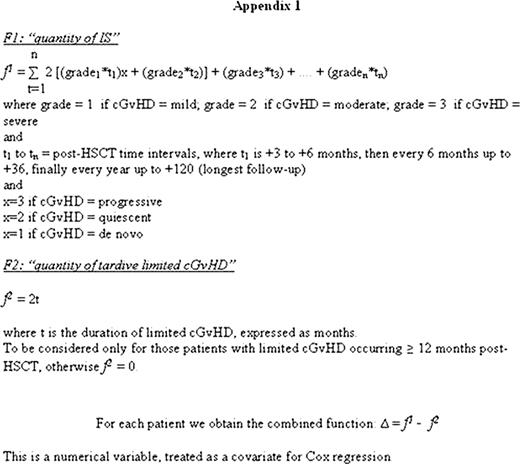Abstract
Abstract 4549
chronic graft-versus-host disease (cGvHD) after allogeneic hematopoietic stem cell transplantation (HSCT) for hematological malignancies is known to be associated with lower relapse risk, due to graft-versus-tumor effect. On the other hand, severe, extensive form of cGvHD is associated with high transplant-related mortality (TRM), mainly due to infectious complications as a consequence of the immunosuppressive treatment (IS) of cGvHD. Not only severity of cGvHD but also its presentation and duration of IS is responsible for deleterious effects on transplanted patients.
Here we built and evaluated a score taking into account both severity and duration of cGvHD (and related IS), looking for any association with TRM, OS and relapse/progression after HSCT.
study population is represented by adult patients who received HSCT after fludarabine-busulfan-ATG conditioning between May 1999 and June 2010 at out Institution for a hematological malignancy, and who developed cGvHD. cGvHD was retrospectively classified according to NIH criteria into mild, moderate and severe form. Informations on cGvHD presentation (progressive, quiescent or de novo) were also collected. Duration of IS was taken into account as well as any change in cGvHD severity overtime. A combined mathematical function D was built, taking into account severity, type of presentation and duration of IS (appendix 1), and was treated as a covariate in univariate and multivariate Cox models for TRM, OS and relapse/progression.
on 313 transplanted patients transplanted in the above mentioned period, 130 developed cGvHD and represented our study population. The function D showed to predict TRM and OS both in univariate and multivariate analysis (table 1); a borderline association was found with relapse/progression, in univariate analysis.
Uni- and multivariate analysis for TRM, OS and rel/pro
| Cut-off variable . | HR . | TRM . | p . | HR . | OS . | p . | Cut-off variable . | HR . | Rel/Pro . | p . |
|---|---|---|---|---|---|---|---|---|---|---|
| 95% CI . | 95% CI . | 95% CI . | ||||||||
| Univariate analysis | ||||||||||
| D | D | |||||||||
| <30 | 1 | 1 | <96 | 1 | ||||||
| ≥ 30 | 10.73 | 1.46–78.59 | 0.02 | 2.63 | 1.12–6.19 | 0.03 | ≥ 96 | 0.20 | 0.02–1.54 | 0.12 |
| Multivariate analysis | ||||||||||
| D | D | |||||||||
| <30 | 1 | 1 | <96 | 1 | ||||||
| ≥ 30 | 10.15 | 1.37–74.93 | 0.02 | 2.25 | 0.94–5.37 | 0.07 | ≥96 | 0.83 | 0.41–1.67 | 0.60 |
| Cut-off variable . | HR . | TRM . | p . | HR . | OS . | p . | Cut-off variable . | HR . | Rel/Pro . | p . |
|---|---|---|---|---|---|---|---|---|---|---|
| 95% CI . | 95% CI . | 95% CI . | ||||||||
| Univariate analysis | ||||||||||
| D | D | |||||||||
| <30 | 1 | 1 | <96 | 1 | ||||||
| ≥ 30 | 10.73 | 1.46–78.59 | 0.02 | 2.63 | 1.12–6.19 | 0.03 | ≥ 96 | 0.20 | 0.02–1.54 | 0.12 |
| Multivariate analysis | ||||||||||
| D | D | |||||||||
| <30 | 1 | 1 | <96 | 1 | ||||||
| ≥ 30 | 10.15 | 1.37–74.93 | 0.02 | 2.25 | 0.94–5.37 | 0.07 | ≥96 | 0.83 | 0.41–1.67 | 0.60 |
Multivariate analysis was obtained after adjustment for: patient's age, HLA matching, stem cell source, comorbidity index, disease status at HSCT.
Patient's age was the only significant variable for TRM and OS in multivariate model; none for rel/pro
Cut-off for D is different among TRM/OS and rel/pro
a function taking into account not only severity but also presentation of cGvHD and duration of IS seems to be predictive of TRM and OS after HSCT. Although further validation is needed, the analytical approach we used here allows to better describe the complexity of post-transplant reality, where severity and duration of IS can change overtime and are associated with patients' outcome.
No relevant conflicts of interest to declare.
Author notes
Asterisk with author names denotes non-ASH members.


This feature is available to Subscribers Only
Sign In or Create an Account Close Modal